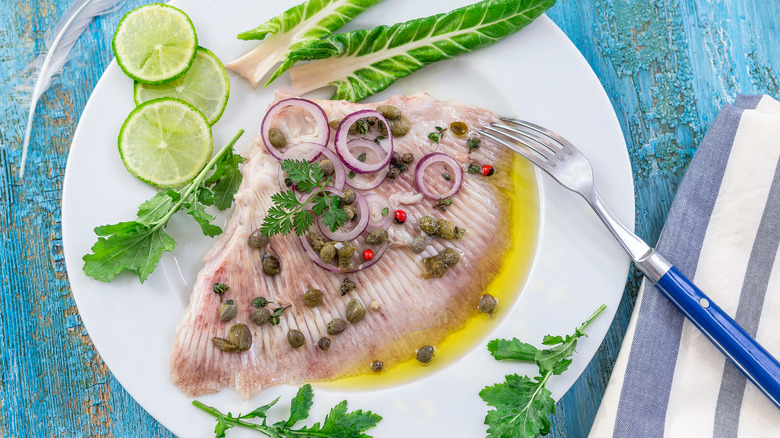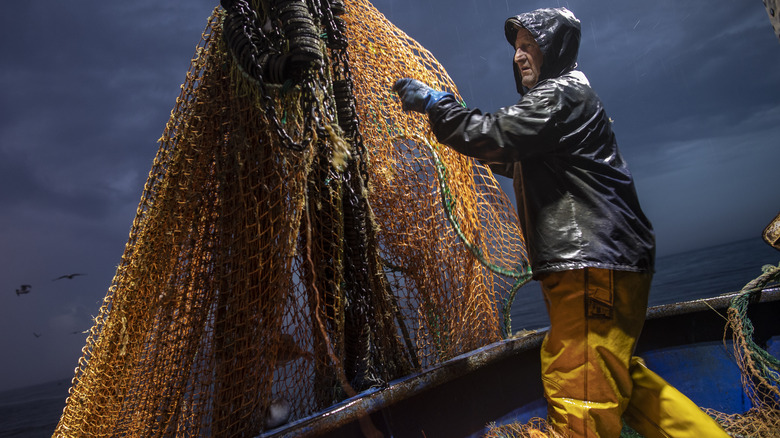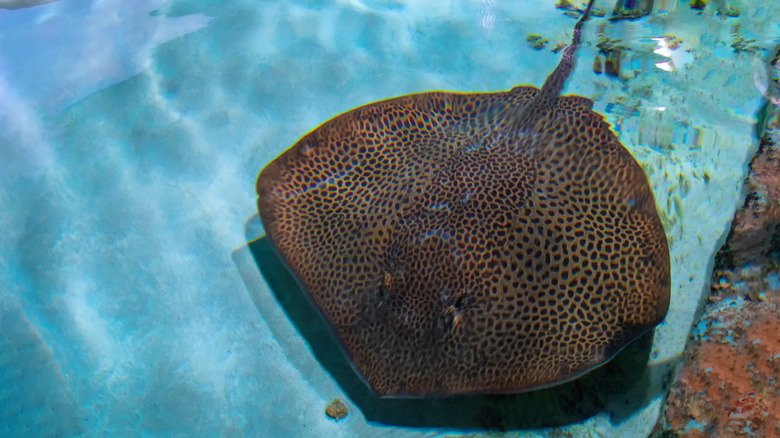The Reason Skate Is An Overlooked Seafood Option In The US
You may not have heard of skate before, unless you're a fish aficionado. So, what exactly is it? Skates are flat aquatic creatures with cartilage skeletons that grow as large as 8 feet long (via Encyclopedia Britannica). They also have wings and tails, giving them almost a manta-ray look. Many different species of skate are found all across the world, but the common skate is particularly well-liked amongst northwestern European diners and those living around the Mediterranean.
Meanwhile, the winter skate is becoming more popular in the U.S., according to Buying Seafood. Thankfully, skates for hungry Americans can be sourced nearby, as they are often caught off the shores of New England or in the Mid-Atlantic. However, they are not regularly sought out, more often ending up in fishing trawls by chance. Typically, when a fisher came across them, skates would sometimes end up as lures for crustaceans or even tossed into the garbage. Lately, though, more people are getting an appetite for them; although not as large as the common variety, these winter skates are still a filling meal, weighing in at about 15 pounds (via Florida Museum).
According to Seafood Source, winter skate isn't the only species found near the U.S., either: Other eastern varieties include the barndoor, clearnose, and thorny skates. There are even a few West Coast varieties out there. So, with so many of them floating around, why haven't most of us heard of or tasted them before?
Why skate isn't popular
As nocturnal bottom-dwellers (via Florida Museum), winter skates aren't exactly champing at the bit to be caught. Not to mention, some have spiky protrusions that scare off predators, including men and women of the sea. Mature winter skates don't typically have such pronounced armor, but their dangerous relatives may have still created a negative reputation for the whole family. Plus, they're finicky, notes The Washington Post: While they can have a disagreeable texture if they're too fresh, they can also spoil quite easily, especially if not kept under ideal airy and icy conditions. If you detect the scent of ammonia, it's probably best to avoid that particular catch.
As if all that weren't enough, per Encyclopedia Britannica, skates also take a while to procreate. Their small birth numbers can easily result in a lack of specimens, so they're more susceptible to overexploitation: Unfortunately, common skates have been endangered since the turn of the millennium, and critically so since just a handful of years later in 2006. So if you find yourself on the other side of the pond, you may want to skip the skate if you suspect it wasn't sustainably sourced.
What about the winter skate more often found near America, though? As of 2019, winter skates were also declared endangered by the International Union for Conservation of Nature –perhaps another reason why environmentally-concerned consumers might steer clear. Still, if caught in a responsible manner, could it be worth trying?
Why you might try it anyway
Winter skates are considered an underused fish, per Buying Seafood, that could and perhaps should replace some of your other nautical favorites. Eating lesser-known seafood can provide an economic boost to fishers who face stiff competition for big-name catches. By requesting a specific yet obscure species, you give up-and-coming business owners a niche to fill in the seafood market. They can then go out and catch something that there would be minimal profit in looking for otherwise.
Skates, whose pectoral fins boast delectable scallop-like flavors, are also good for your wallet and stomach. Wing filets tend to be cheaper to buy than most alternatives you find at the market, and if you're looking for nutritional value, they carry a good deal of lean protein (via The Washington Post). Some of the most popular cooking techniques used for these fish are ones you're likely already familiar with, including baking, frying, poaching, and sauteing. Then, depending on how it's prepared, you can lather it up or even toss it into a broth — the wings' shape will naturally retain toppings.
If you do decide to try skate, though, you'll likely have to make a special request with a fishmonger. You might find skate in some high-end seafood restaurants or specialty fish markets if you're lucky, but don't count on it — and the chances of stumbling upon it at your local grocery store or everyday seafood joint are pretty low. Still, there are plenty of fish in the sea, and if you get the chance, this one may just be worth seeking out.


